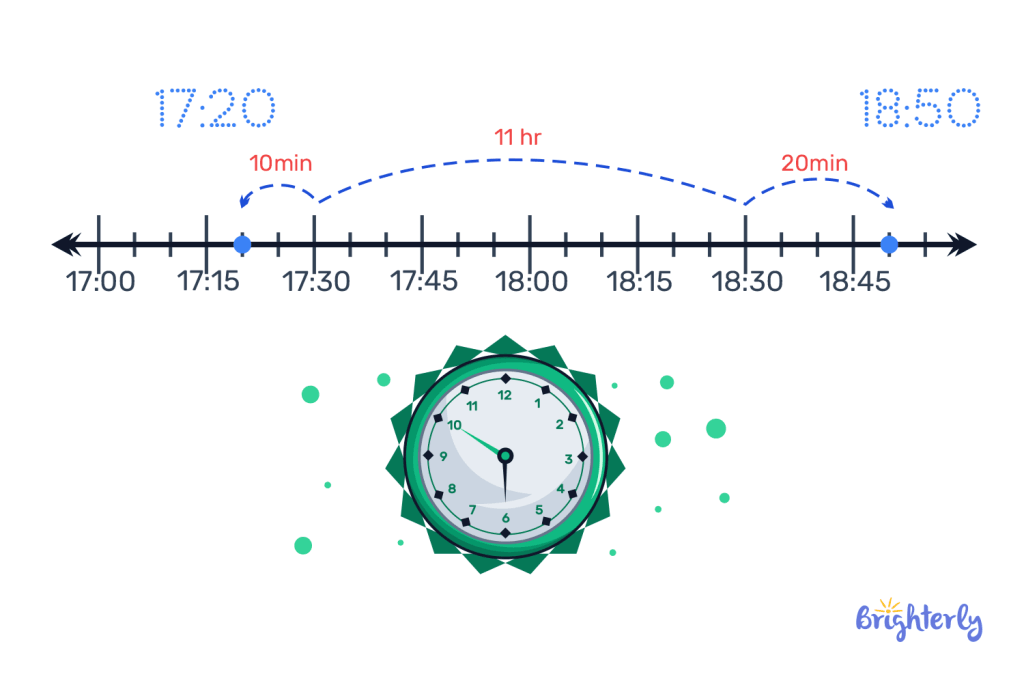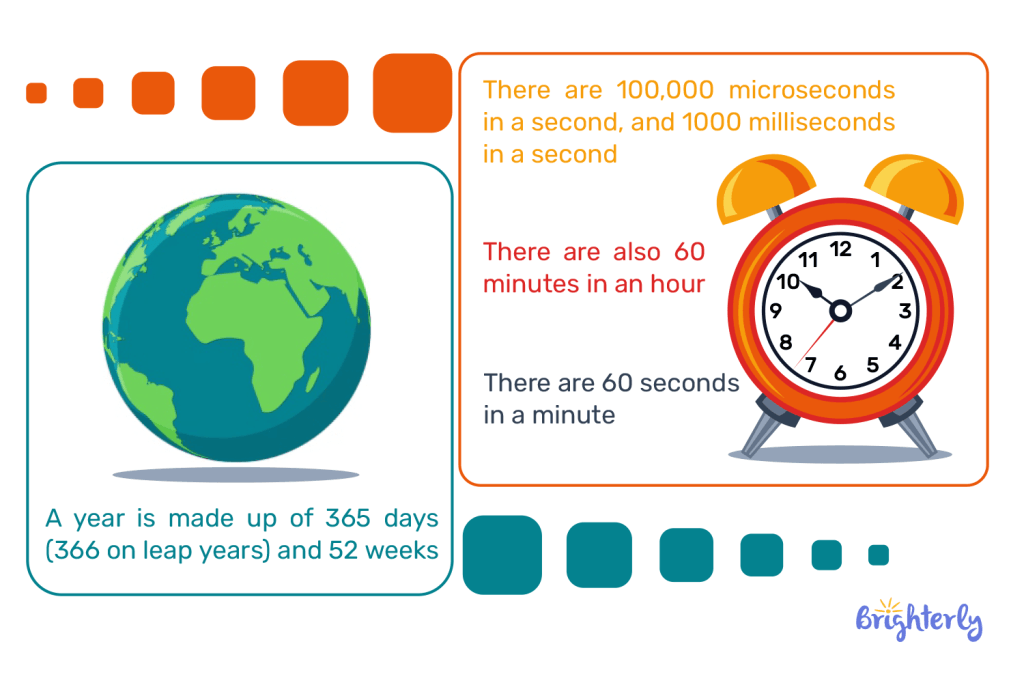Time Interval – Definition, Units of Time, Examples
Updated on November 3, 2025
Ready for another fascinating journey through math with Brighterly? You’re in the right place!
Today, we’re going to explore the time interval. Our lives contain many time intervals, and there are many ways we define them. They’re essential to not only your math and science classes, but also in understanding the passage of time.
Here, we’ll cover the time interval definition, units of the time interval, its properties and characteristics and what is time interval in physics. We’ll also show you how to calculate time intervals and share practice problems for you to solve.
What is time interval?
A time interval is any measurement of time that passes between two events. These events can be anything from the start of your math class to the end of it, or from when you go to sleep to when you wake up.
You’ll notice that clocks are also divided into intervals, like 15 minutes, 30 minutes, or hours. But they can also be measured in other units, including days, weeks, fortnights, months, and years.
Time intervals represent how we organise our lives. Your school day is one of them, as are your classes and activities like football practice. You use such measurements when cooking meals, travelling to school or work, and during exams.

Definition of time interval
The time intervals meaning is a period of time. Usually, it’s marked at the beginning by an event and at the end by another event. Time intervals not only play a big part in our lives, but they are also integral to math and physics. We’ll cover their importance to these subjects a little later on.
Units of time interval
- Milliseconds
- Microseconds
- Seconds
- Minutes
- Hours
- Days
- Weeks
- Months
- Years
- Decades
- Centuries
- Millennia
Most commonly, you’ll use seconds, minutes, hours, weeks, months and years in both math class and everyday life. You may come across the larger measurements of time in history class, where we talk about events from centuries and millennia ago.
The smaller units of time intervals, like milliseconds and microseconds, are used to measure actions very precisely, like computer processing speeds or camera shutter speeds. You’re most likely to come across them in science or computing classes.
Characteristics of time intervals
Now that you know the time interval meaning, it’s time to explore the shared characteristics of time intervals:
- They are scalar quantities, meaning they only represent magnitude (aka size), and can be represented by one number
- Because time only moves forward and not backwards, time intervals will always be zero or positive — they cannot be negative
- Time is cumulative and we can add time intervals together. For example, if you had 6 classes today and they were 1 hour each, you had 6 hours of classes.
Properties of time intervals
As well as the characteristics we’ve covered, time intervals also have some interesting properties that they all share:
- Time is continuous, meaning time intervals are continuous too
- Time intervals are uniform, meaning the amount of time they measure is always consistent
- They are absolute — no matter your perception of time, time intervals are unchanging
You might have noticed that sometimes time feels like it moves faster or slower. For example, if you’re having a fun day, it might feel like it’s over quicker than usual. If you’re bored, time might feel like it’s moving slowly. But time always moves at the same pace, and that’s just your perception of time.
Understanding different units of time
Different units of time represent smaller and larger time intervals. This means that larger units are made up of smaller time intervals, helping us track time more effectively. For example:
- There are 100,000 microseconds in a second, and 1000 milliseconds in a second
- There are 60 seconds in a minute
- There are also 60 minutes in an hour
- In a day, there are 24 hours
- 1 week is made up of 7 days
- A year is made up of 365 days (366 on leap years) and 52 weeks
- There are 10 years in a decade
- A century is made up of 100 years, or 10 decades
- There are 1000 years in a millennia, or 10 centuries

Importance of time interval in physics
Time intervals are an important concept in math. But time interval physics are fundamental too. The time interval definition physics is the same as in math, but accurately measuring intervals time in physics is important to calculating velocity, acceleration and many other more complex measurements.
Often, in physics, time intervals are combined with other measurements to calculate things like acceleration. For example, a car accelerating is travelling a higher distance in fewer time intervals as it accelerates, making time intervals key to working out its acceleration.
Difference between different units of time
Every time interval is a finite unit of time, unchanging and continuous. Having different units of time helps us measure time more accurately as it goes on, meaning we don’t need to measure large periods of time with smaller measurements.
Each time interval fits into another time interval, as we can see above. 60 seconds add up to a minute, while 60 minutes add up to an hour. Using different units of time helps us measure time more accurately, no matter how long or short a defined interval is.
Equations involving time intervals
There is no defined equation for the time interval, but there are many different equations that involve time intervals. To calculate frequency for example, you’d use the equation: frequency = 1 ÷ time period.
Let’s look at the time interval formula physics for speed, which involves the time interval. This equation is speed = distance ÷ time.
Another equation we use time intervals in is calculating acceleration: acceleration = change in velocity ÷ time.
Conversion of units of time
Converting between units of time helps you work with time intervals better and record time more accurately. Here are some of the most common conversions between units of time you’ll use often:
- 1 minute = 60 seconds
- 1 hour = 60 minutes
- 1 day = 24 hours
- 1 week = 7 days
- 1 year = 52 weeks = 365 days
How to calculate time intervals?
There may be times where you’re required to calculate time intervals — for example, working out the time that has passed between 9.30am and 12pm. Here’s a step-by-step process on calculating time intervals:
- Identify your starting and ending times — here, it’s 9.30am and 12pm
- If your starting and ending times are in the same unit (e.g. hours), subtract the start from the end.
- If they’re in different units (e.g. hours and minutes), like our example, convert them to the same units. You can either calculate the minutes (570 and 720) or use decimals (9.5 hours and 12 hours).
- Subtract your starting time from your ending time — this means the time difference is 150 minutes or 2.5 hours.
Time intervals: Practice problems
Now it’s time to put your new knowledge on time intervals to the test. We’ve created some practice problems — either calculate the answers mentally or use a pen and paper to work them out!
- You go to see a movie that starts at 3pm, and ends at 5.15pm. How long did the movie last in hours and minutes?
- You’re running a race and you complete it in 1 hour 30 minutes. Your friend finishes in 2 hours. What is the interval time between you finishing and them finishing?
- You have a plant that has grown from a seed to a sapling in 4 weeks. How many days has it taken to grow?
- How many hours are in a leap year?
Conclusion
Here, we’ve covered the time interval definition, different units of time and how to calculate time intervals. Now you can confidently understand, calculate and apply time intervals in your life and in your math and science classes. Whether you want to understand how long you spend in school or you’re measuring the speed a vehicle is travelling, you have all the skills you need!
Time intervals: Frequently asked questions
What do time intervals mean?
Time intervals mean the duration of time between one event and another event. This could be the time between your math class starting and finishing, and you can measure it in seconds, minutes and hours. Other units of time measurement include days, weeks and years.
What is a time interval in simple terms?
In simple terms, a time interval is a unit of time that occurs between one event and another. It refers to the passage of time and can be measured in different units. The time between you leaving school and arriving home is an interval of time, for example.
What are the units of time?
The most common units of time include:
- Seconds
- Minutes
- Hours
- Days
- Weeks
- Months
- Years
You may also encounter very small or large units of time like milliseconds or millennia.
How do you calculate time intervals?
To calculate a time interval, take your starting time away from your finishing time. If you go to football practice at 4pm and finish at 5.15pm, take 4pm away from 5pm in minutes (240 and 300) or time intervals (i.e., intervals of 15 minutes). The time interval is 1 hour 15 minutes, or 75 minutes.







